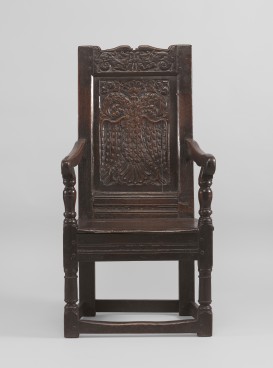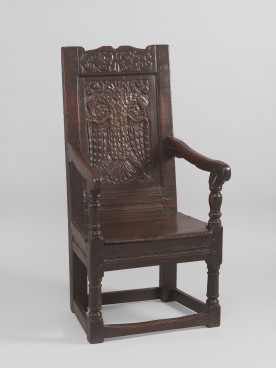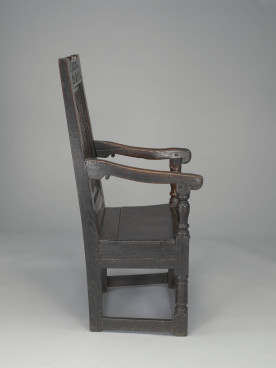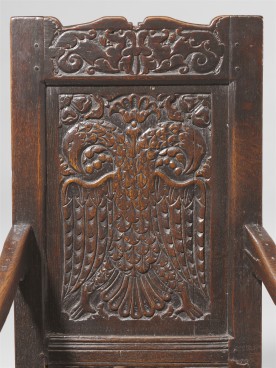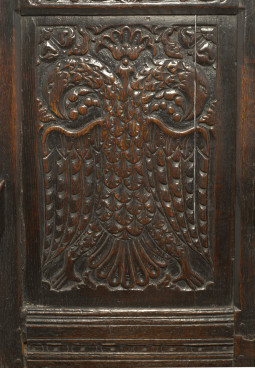Armchair, c.1620–50
Oak
This chair bears the heraldic badge of the double-headed eagle, possibly the arms of the Speke family of Whitelackington House, Ilminster, Somerset. The top edge of the back panel is stamped with the initials
‘TW’. It was formerly in the collection of early oak specialist Tobias
Jellinek (b.1934).
Victor Chinnery Catalogue
Description
An oak panel-back armchair, the ogee-shaped top rail carved with a pair of addorsed
dragons above a single panel carved with an heraldic double-headed eagle (possibly the badge of the Speke family of White Lackington House, Whitelackington, Somerset)
Dimensions
Ht: 44″ (112cm) : 22″ (56cm) D: 20″ (51cm)
Materials
Oak
Dating
c. 1620-50
Construction
Ogee-shaped top rail above a single panel and flanked by gently down-curved arms raised on baluster-turned supports, the two-plank moulded trapezoidal seat raised on channel-moulded and stamped seat-rails with column-turned front legs united by plain stretchers, the legs extended to form feet.
Marks or Stamps
The back panel branded TW.
Condition
Generally good, the surface richly patinated and rubbed. Small patch to front edge of seat. The feet somewhat reduced in height.
Additional Remarks
A chair of somewhat similar character and proportion was sold by Sotheby’s Bond Street, London (Sherwood Sale, 22 May 2002, Lot 306), though this was wrongly catalogued as Scottish (on the basis of the inclusion of thistles in the carving of the panel – in fact thistles are commonly included in the decoration of English furniture and have little or no regional significance).
The double-headed eagle motif appears in several English coats of arms (e.g. Speke, Norreys) and as supporters to arms (e.g. Corporation of the City of Salisbury – see Victor Chinnery, Oak Furniture – The British Tradition, Woodbridge 1979, frontispiece, pp. 448-9). The Speke family of Ilminster, Somerset, own an early 17th century cypresswood chest carved with the double-headed eagle, no doubt ordered by an ancestor whilst on the grand tour in Northern Italy. The same motif appears on a fine chair-table at the Red Lodge Museum, Bristol; on a boarded aumbry in the Burrell Collection, Glasgow (ill. Victor Chinnery, op. cit., p. 416, Fig. 4:9); a pair of pierced-panel doors sold by Sotheby’s, London, the Cold Overton Sale, 10 October 1986, Lot 48; and a pedimented mural cupboard with very similar doors was sold by Christie’s South Kensington, 2 July 2003, Lot 124.

